raga.io
🟠 Agar.io Clone with Akka.
Raga.io
AI Disclaimer
During the preparation of this work, the authors used Chat-GPT and Gemini to refine the report by improving sentence structure and correcting grammatical errors. After using these tools, the authors reviewed and edited the content as needed and takes full responsibility for the content of the final report.
Abstract
Agar.io is an online, massively multiplayer action game. Players take on the role of a small, circular cell inside a map that resembles a Petri dish. The primary goal is to grow as large as possible by consuming smaller cells, both those controlled by other players and those that are scattered randomly throughout the game world as food. This simple premise leads to a dynamic and competitive environment where a player’s size directly dictates their power and vulnerability. Players can join a randomly assigned game session, create a new session, or join an existing one using a unique session ID. The session ends only when the player is eaten or decides to quit.
The goal of this project is to design and develop a clone of Agar.io with a robust client–server architecture, ensuring scalability, performance, and smooth multiplayer interaction.
Achievements:
- Developed a real-time client–server architecture supporting multiple concurrent players.
- Implemented smooth synchronization and communication protocols to minimize lag.
- Designed an efficient game loop for rendering, collision detection, and player interaction.
- Created scalable server logic capable of handling large numbers of simultaneous connections.
- Implemented core game mechanics: cell growth, collision handling, food spawning, and player elimination.
- Delivered a competitive multiplayer experience close to the original Agar.io.
Concept
This project is a desktop application with a graphical user interface (GUI) packaged as a Java Archive (JAR) file. It can be executed on any system with a Java Runtime Environment (JRE) installed.
- Primary Users: The game is designed for casual gamers who enjoy competitive multiplayer experiences. Players can be located anywhere worldwide, as it is built for online play.
- Usage Patterns: Sessions are typically short and played during leisure time, ranging from just a few minutes up to an hour.
- Interaction Method: Players interact through a graphical user interface (GUI) on desktop computers, using a mouse to control their in-game cell.
- Data Handling: No personal data is stored. The system only maintains temporary session data (e.g., player positions, scores), which is discarded once the session ends.
- User Roles: There is only one role: Player. All users share the same capabilities, with no role-based differences or special permissions.
Requirements
Functional Requirements
- Ability to join a random game session.
- Ability to create a new game session.
- Ability to join an existing session using a unique session ID.
- Support for multiple concurrent players in a session.
- Acceptance criteria: at least 5 concurrent players per session.
- Real-time visibility and interaction between players.
- Acceptance criteria: latency < 200ms.
- Low-latency handling of movements and actions.
- Acceptance criteria: maintain a frame rate of at least 30 FPS during typical gameplay.
- Mechanism for consuming smaller cells (players or food) to increase size.
- Acceptance criteria: players can consume smaller cells and visibly grow in size.
- Random spawning of food items within the map.
- Collision detection and outcome resolution based on cell size.
- Sessions conclude when a player is eliminated or chooses to exit.
- Intuitive GUI for session management.
- Button to join a random session.
- Nickname input field.
- Button to create a new session and join it.
- Input field for entering a session ID to join an existing session.
- Button to join the specified session.
- Visual representation of player cells, food items, and other players.
- Display player names.
- Display the session ID so players can share it with friends.
- Scalable server architecture to handle increasing player numbers.
- A master server coordinating multiple game servers that manage individual game sessions.
- Dynamic allocation of players to game servers based on load and availability.
- The server architecture should support scaling to accommodate increasing numbers of concurrent sessions and players.
- Backup and failover mechanisms to ensure session continuity in case of game server failure.
Design
Architecture
This project employs a client-server architecture with a distributed system design. The architecture consists of three main components: the Client, the Mother Server, and multiple Child Servers.
Infrastructure
Deployment
The system architecture consists of three main components:
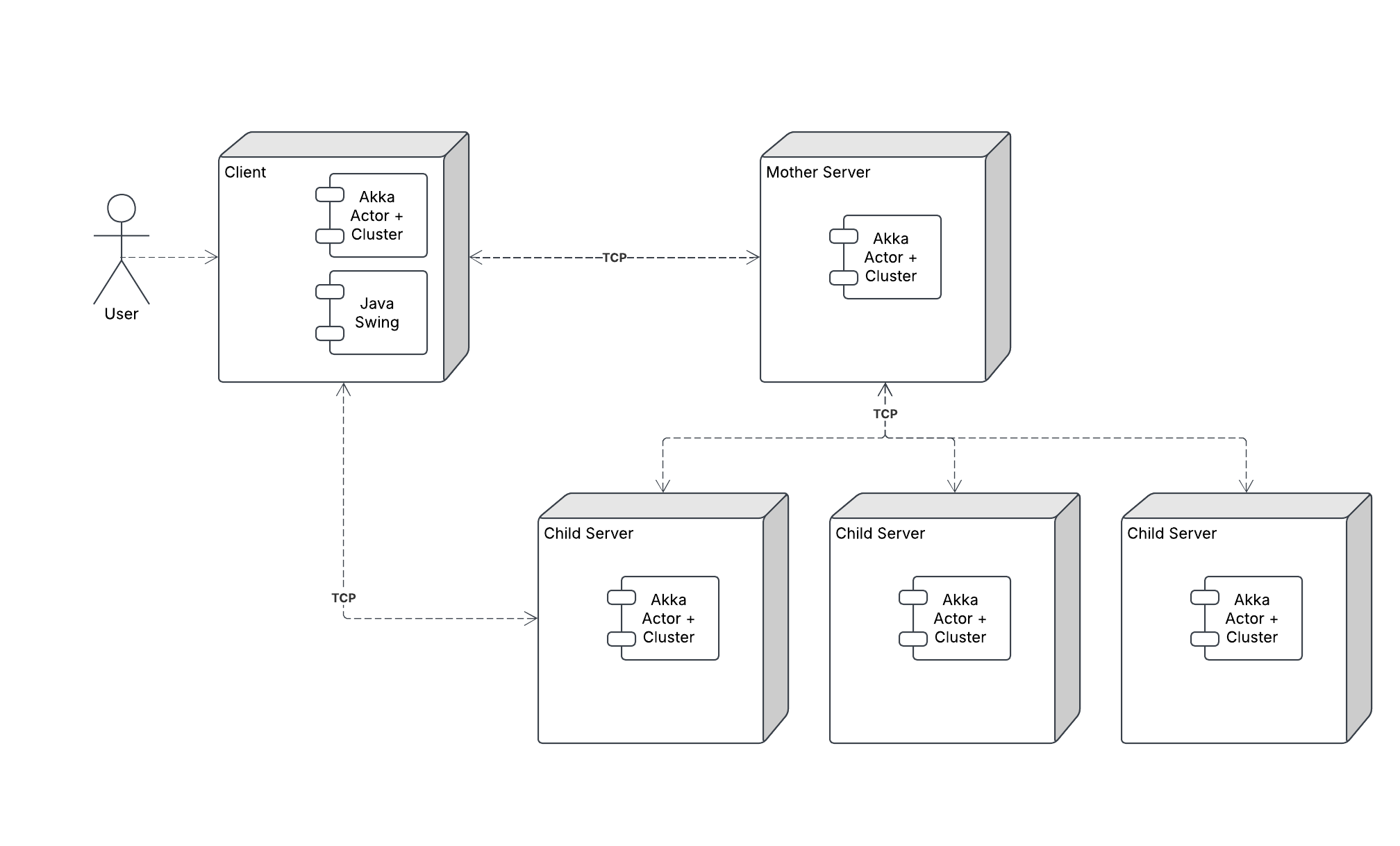
- Client: The client application is a desktop GUI that players use to interact with the game. It handles user input, renders the game state, and communicates with the servers.
- Mother Server: The Mother Server acts as a central coordinator. It manages game sessions, handles player matchmaking, and distributes players to Child Servers based on load and availability.
- Child Servers: Each Child Server manages one game session. It handles real-time game logic, player interactions, and communicates with the Mother Server for session management.
Components
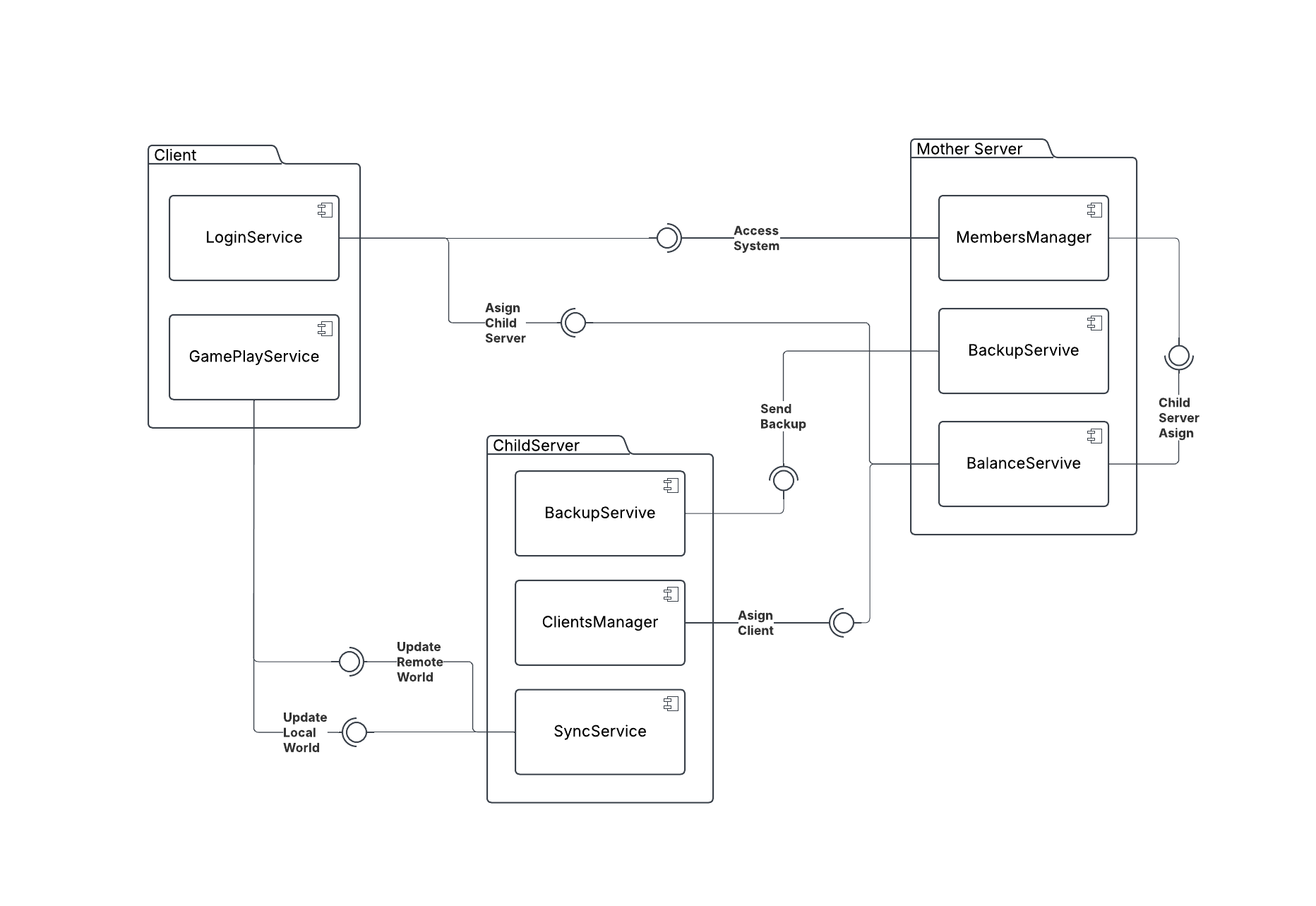
Client service:
- LoginService: manages user connection with the Mother Server.
- GamePlayService: handles gameplay activities and user interactions and communicates with the Child Server for real-time updates.
Mother Server service:
- MembersManager: discovers Clients and Child Servers that access the system and manages pending Clients when no Child Server is available.
- BackupService: handles backup data from Child Servers.
- BalanceService: distributes clients to Child Servers based on load.
Child Server service:
- BackupService: manages local backups and forwards them to the Mother Server.
- ClientsManager: receives and manages clients assigned from the Mother Server.
- SyncService: synchronizes the game world state between local and remote instances.
This architecture allows for scalability, as multiple Child Servers can be added to handle more game sessions as needed. The Mother Server is the seed node of the system and must always be started first. Child Servers can be started and stopped dynamically, allowing for flexible resource management. Child Servers can be hosted on different machines or cloud instances to distribute the load effectively, it’s not mandatory to have them on the same network or datacenter as the Mother Server.
Modelling
Client
The client, which has a graphical user interface (GUI), is structured according to the Model-View-Controller (MVC) architectural pattern, which separates the application into three interconnected components: the Model, the View, and the Controller.
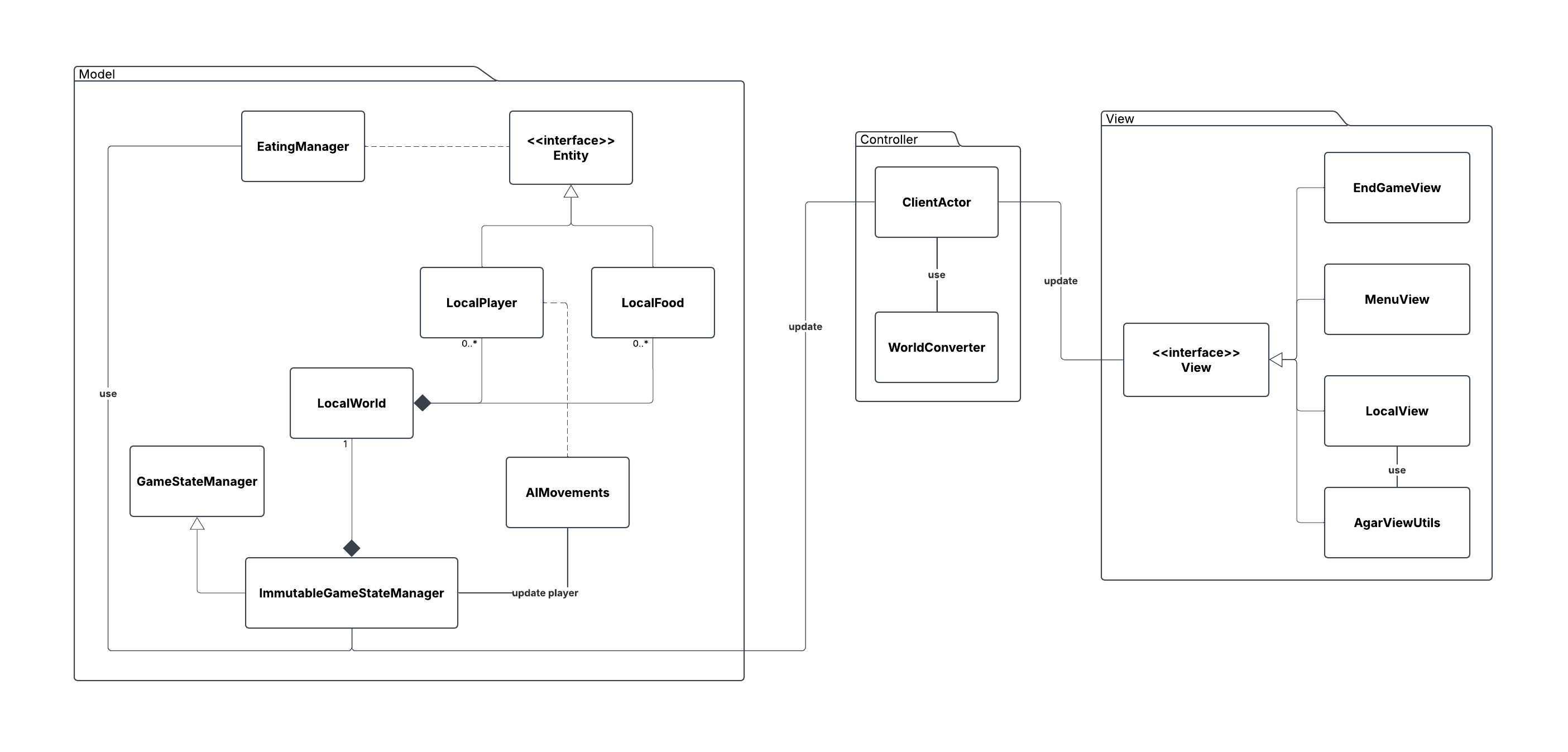
Client Model
The Model encapsulates the game logic and state management:
- Entity (interface): A common abstraction implemented by LocalPlayer and LocalFood.
- LocalPlayer and LocalFood: Entities within the game world.
- LocalWorld: Represents the game environment, containing multiple players and food objects (composition relation).
- GameStateManager and ImmutableGameStateManager: Handle the game state. The immutable version provides read-only access to the state.
- EatingManager: Handles interactions related to eating mechanics between entities.
- AIMovements: Updates the behavior and movement of AI players, if present.
Client Controller
The Controller handles interactions and updates between the model and the view:
- ClientActor: Central controller component managing the game flow and communication with servers.
- WorldConverter: Used by ClientActor to transform model data into a format suitable for the local computation.
Client View
The View presents the game to the user:
- View (interface): General abstraction for different visual components.
- MenuView, EndGameView, LocalView: Different visual representations of the game’s state (menu, in-game, end screen).
- AgarViewUtils: Utility functions used by LocalView to draw game elements.
Mother Server
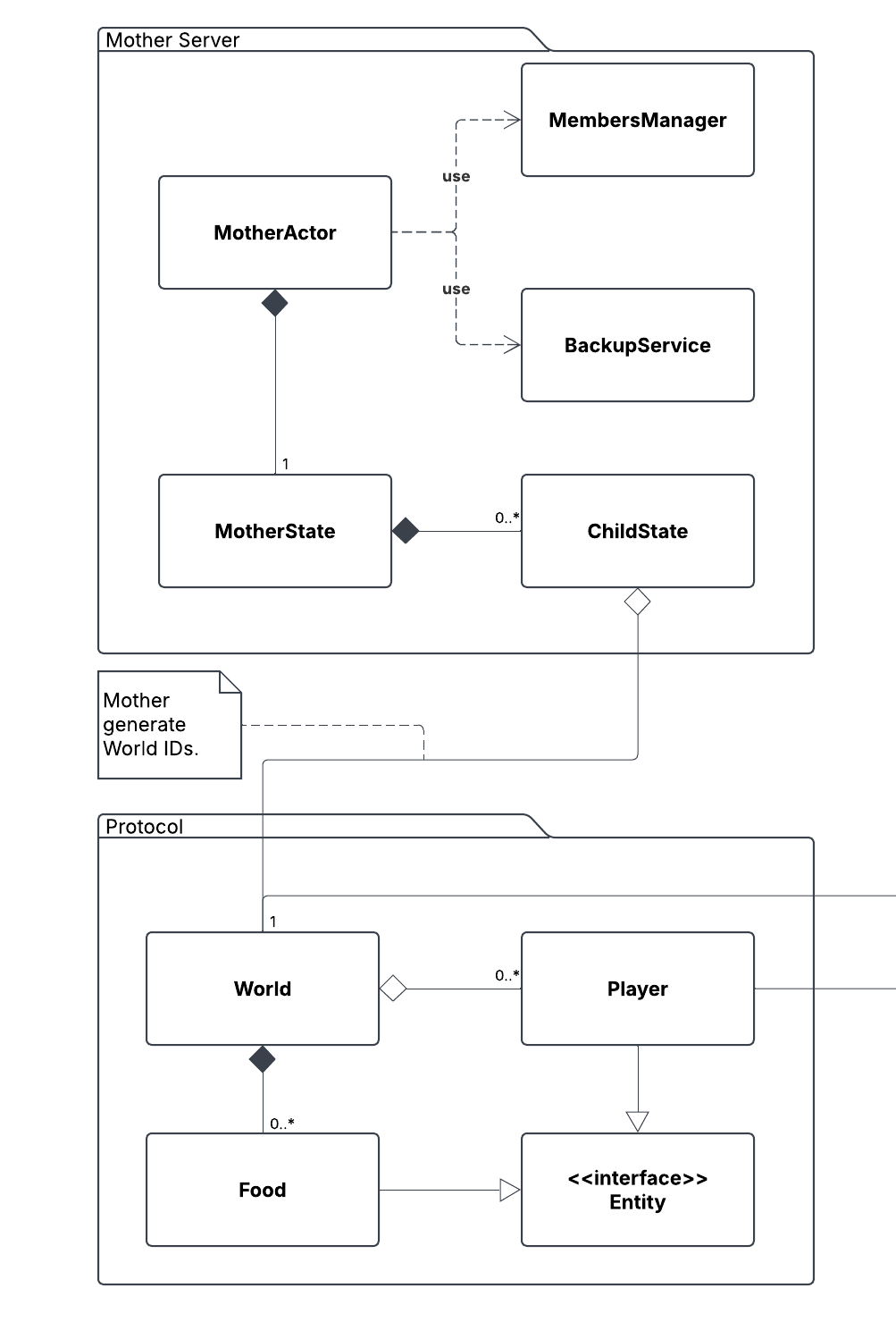
The Mother Server coordinates the main management logic:
- MotherActor: The central actor of the system.
- MembersManager: Discover Clients and Child Servers that access the system.
- BackupService: Manage data backup operations.
- MotherState: Store the Child Servers and pending Clients references.
- ChildState: Represent the state of a Child Server, including its load and the world’s ID managed.
Child Server
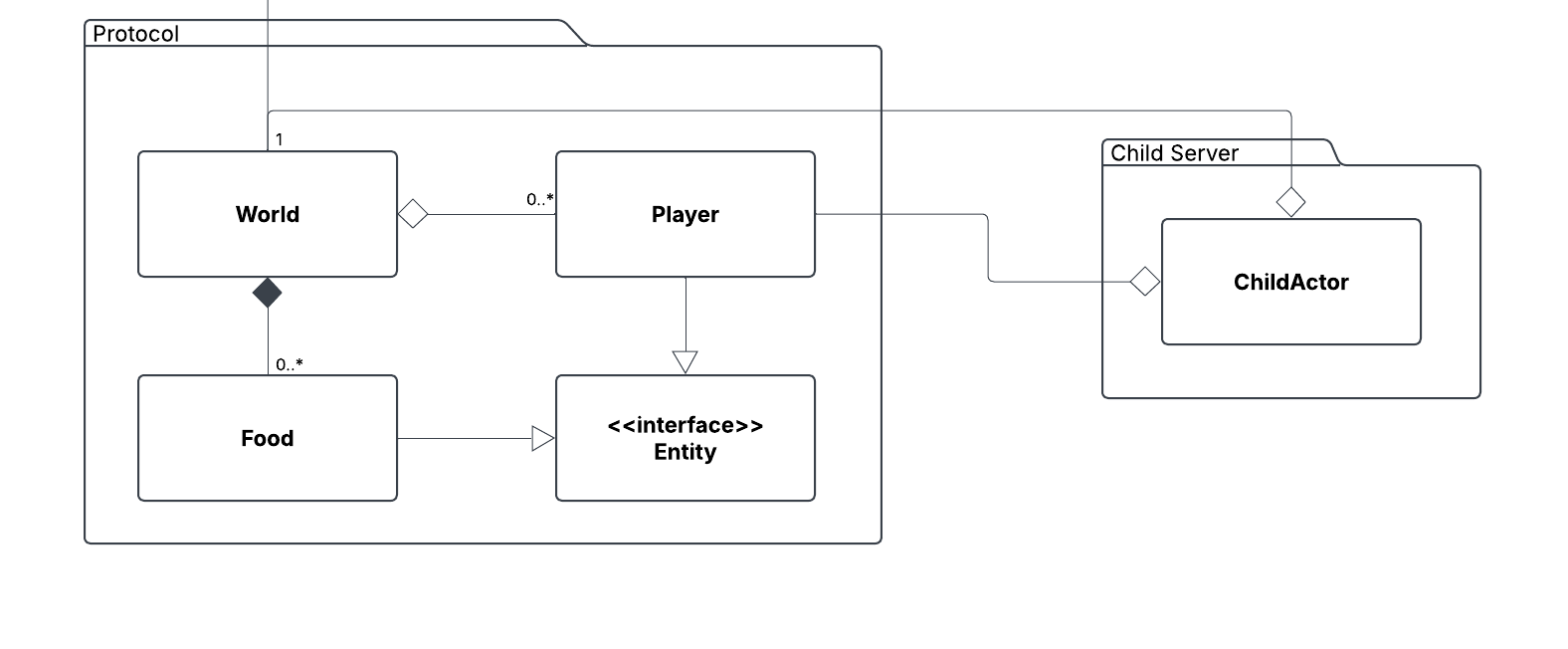
Child Servers manage individual game sessions and receive players from the Mother Server.
Protocol
As seen in the class diagrams above, there are a set of classes shared between the Mother Server and Child Server components. These classes are used to represent the world state of a game session and they are the body of the messages exchanged to synchronize the game state between the servers and the clients and also between the Mother Server and Child Servers. They include:
- Entity (interface): A common abstraction implemented by Player and Food.
- Player: Represents a player in the game, including attributes like ID, nickname, position and size.
- Food: Represents a food item in the game, including attributes like ID, position and size.
- World: Represents the game world, containing multiple players and food objects.
Full Diagram
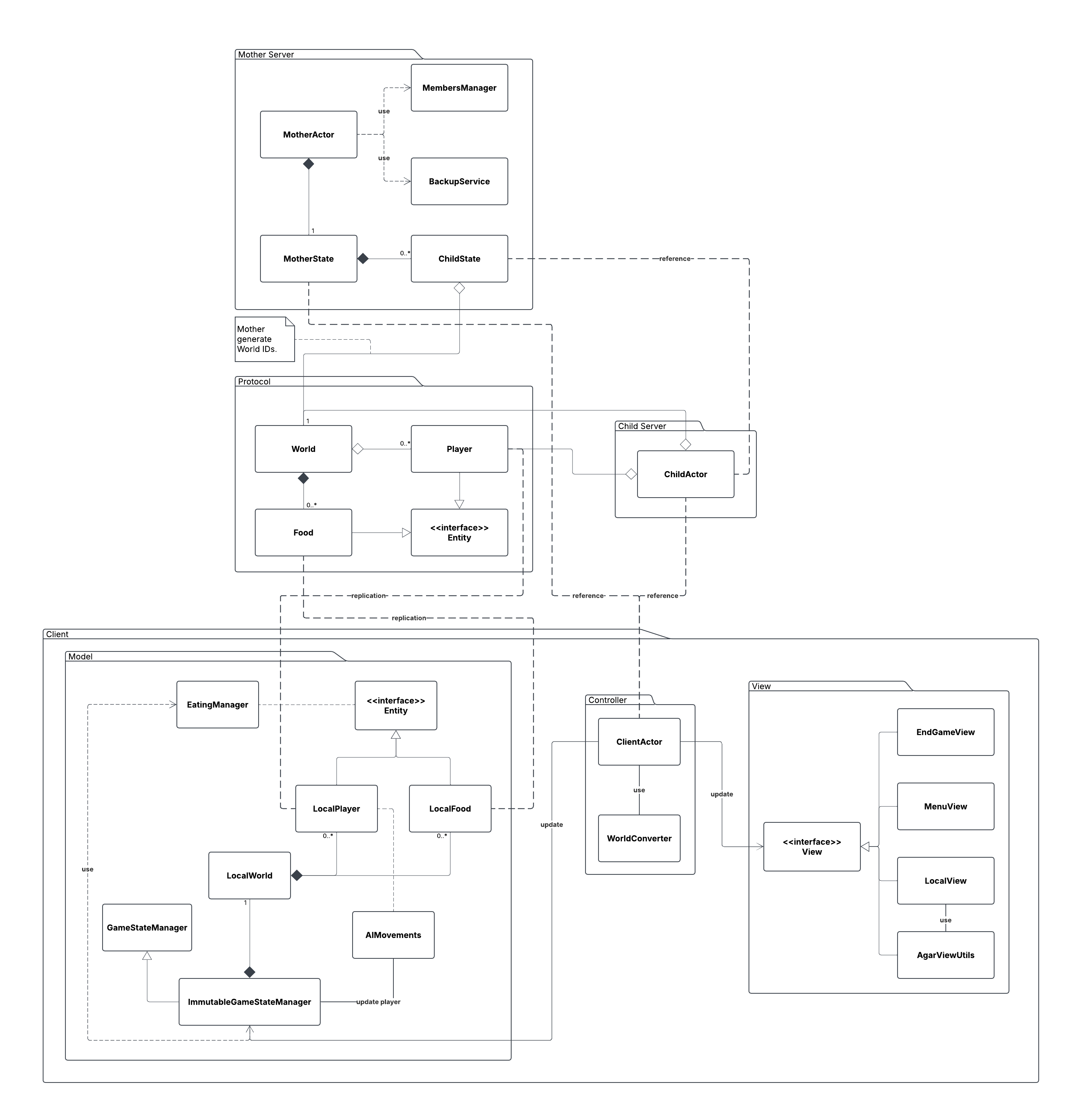
Interaction
Client - Mother Server - Child Server connection and gameplay flow
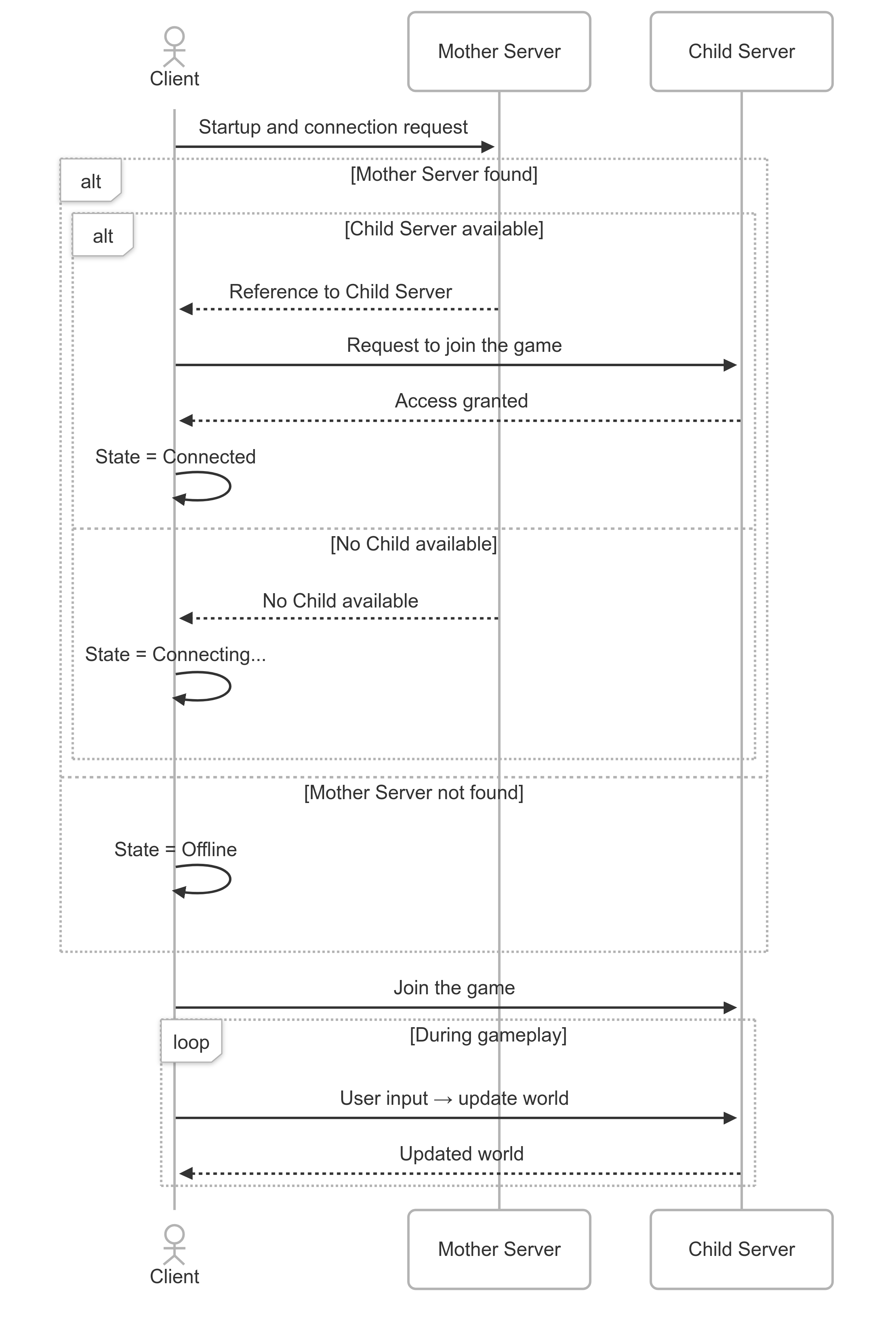
- When the Client is launched, it tries to connect to the Mother Server.
- If the Mother Server is not found → the Client remains in Offline state.
- If the Mother Server is found:
- If a Child Server is available:
- The Mother Server provides the Client with a reference to the Child Server.
- The Client requests to join the game through the Child Server.
- The Child Server grants access, and the Client state becomes Connected.
- If no Child Server is available:
- The Mother Server informs the Client that no Child is available.
- The Client remains in the Connecting… state.
- If a Child Server is available:
- Once a Child Server is assigned, the Client officially joins the game.
- During gameplay, for every user input:
- The Client sends the input to the Child Server requesting a world update.
- The Child Server processes the request and sends back the updated world to the Client.
Mother Server - Child Server flow
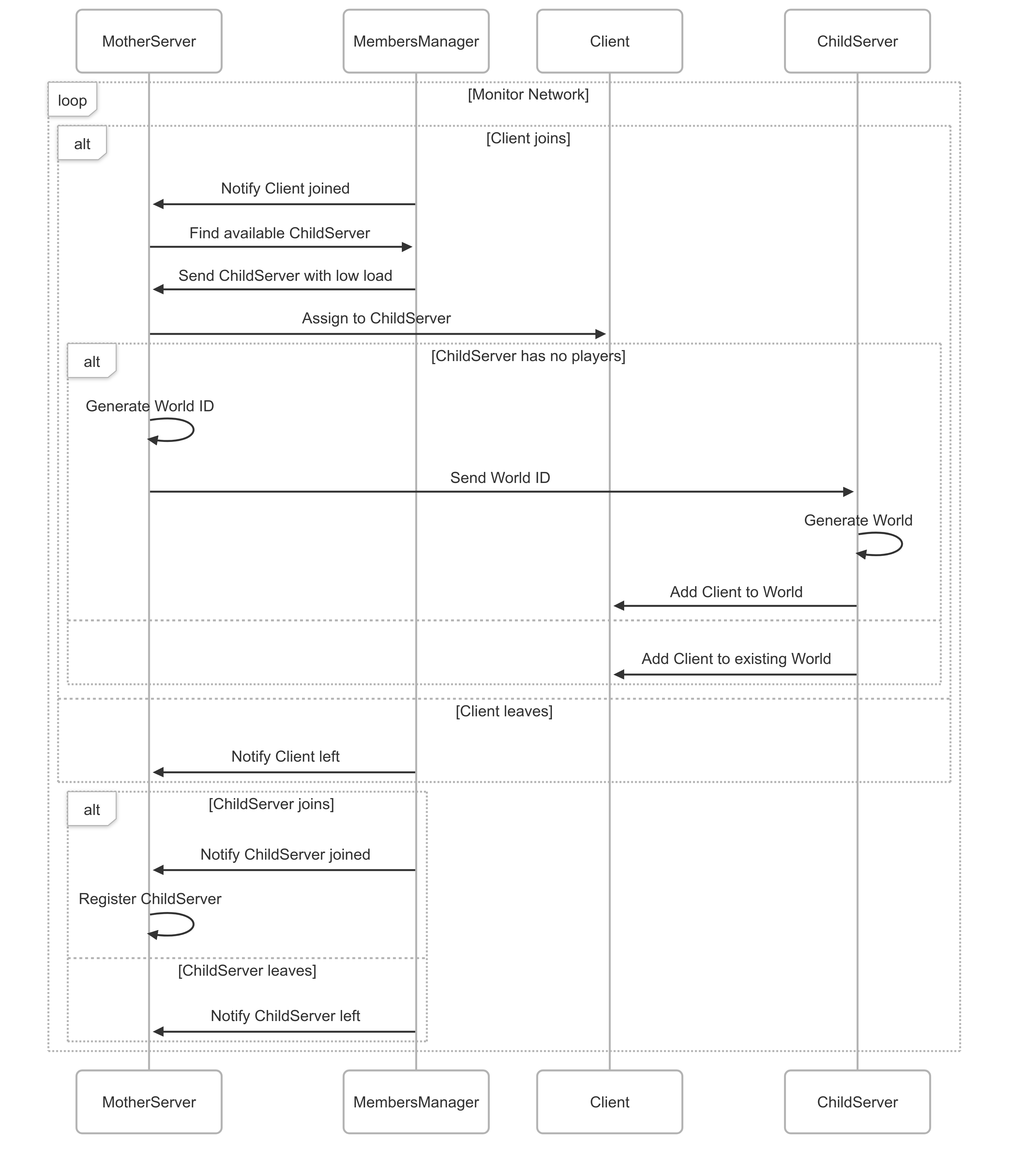
-
MembersManager continuously monitors the network.
- When a Client joins:
- MembersManager detects the client.
- It notifies the MotherServer.
- MotherServer looks for a ChildServer with low workload.
- MotherServer assigns the ChildServer to the Client.
- If the selected ChildServer has no players:
- MotherServer generates a new World ID.
- Sends the World ID to the ChildServer.
- ChildServer generates the world.
- Client is inserted into the newly created world.
- Otherwise:
- Client is added to the existing world.
- When a Client leaves:
- MembersManager notifies the MotherServer and the MotherServer informs the ChildServer to remove the Client from the game.
- When a ChildServer joins:
- MembersManager notifies the MotherServer.
- MotherServer registers the ChildServer as available.
- When a ChildServer leaves:
- MembersManager notifies the MotherServer.
- MotherServer removes the ChildServer from its registry.
Backup flow
Behaviour
Client Actor
ClientActor orchestrates the entire lifecycle of the client-side logic: it initializes the UI, discovers the cluster, requests a game session, and runs a synchronized game loop with the server. It transitions between two main modes:
- Homepage mode (
viewBehavior): discovery, matchmaking, and session acquisition. - In-game mode (
run): simulation–render–synchronization loop with the Child Server.
It also processes user actions (e.g., JoinRandomRoom) and handles end-of-game transitions.
Initialization
When apply() is invoked:
- Logs startup and initializes the main View, displaying the status “Offline”.
- Registers itself in the Akka Receptionist under
CLIENT_SERVICE_KEY. - Subscribes to cluster membership events with
JoinNetwork. - Enters Homepage mode by invoking
viewBehavior(view).
At this stage, the actor becomes discoverable and begins reacting to cluster state changes.
Homepage Mode
In this mode manages all events prior to entering a game session. It may hold an optional reference to the Child Game Manager (manager: ActorRef[ChildEvent]).
Handled messages
JoinNetwork(MemberUp)- Displays “Connecting…” in the UI.
- No state change occurs.
GameManagerAddress(managerRef)- Indicates that a game manager was discovered.
- Updates the UI with “Connected”, and transitions to
viewBehavior(view, Some(managerRef)).
LocalClientEvent.JoinRandomRoom- If a manager reference is available, calls
requestWorld(nickName, ctx, manager). - If not, updates the UI with “Connecting…” message.
- If a manager reference is available, calls
ServiceNotAvailable()- Updates the UI with a service-unavailable message.
LocalClientEvent.ReceivedWorld(world, player, managerRef)- Indicates successful session acquisition.
- Steps performed:
- Creates a local world model and player representation.
- Initializes
ImmutableGameStateManagerandLocalView. - Closes the menu and shows the game view.
- Sends an initial
Tickto itself to start the game loop in therunbehavior.
In-Game Mode
This mode handles the main game loop and implements a deterministic, synchronized update pattern.
A timer triggers Tick every 50 ms.
The isSynced flag ensures only one update is in-flight between client and server:
isSynced = true→ the client processes input and sends an update.isSynced = false→ the client waits for the server’s response before proceeding.
Handled Messages
LocalClientEvent.Tick(only whenisSynced = true)- Reads player input direction from
gameView. - Updates the local model (
movePlayerDirectionandtick()). - Detects eaten players and notifies the server (
EatenPlayermessages). - Serializes the world state and sends
RequestRemoteWorldUpdate. - Transitions to
isSynced = falseto await a response.
- Reads player input direction from
ReceivedRemoteWorld(remoteWorld)- Replaces the local model with the authoritative server state.
- Updates and repaints the view.
- Transitions back to
isSynced = true.
EndGame()- Hides the main game view.
- Displays the end game screen via
EndGameView. - Transitions into
endGame()state.
Mother Actor
MotherActor functions as the central coordinator and matchmaker in the Raga.io distributed architecture. It does not manage gameplay logic directly but is responsible for:
- Tracking all active Child Servers and their states.
- Managing Client connections and distributing them to available game servers.
- Handling pending clients when no child servers are available.
- Managing server registration, deregistration, and fault handling.
The actor operates as a stateful event handler that reacts to cluster events and client lifecycle messages, maintaining a dynamic view of the system through its internal MotherState.
Initialization
When apply() is invoked:
- Logs the startup message and registers the actor in the Akka Receptionist using
MOTHER_SERVICE_KEY. - Spawns the
MembersManageractor, which monitors the cluster and forwards membership events. - Initializes its behaviour with an empty
MotherState, containing no children and no pending clients.
At this stage, the MotherActor is ready to accept and respond to system-level events.
Main Behaviour
The actor maintains two key data structures inside MotherState:
children: a list of activeChildStateobjects, each representing a connected child server, its assigned clients, and the associated world ID.pendingClients: a list of clients waiting for assignment because no child servers are currently available.
The actor transitions through different states purely based on incoming messages:
ClientUp(client)- Triggered when a new client joins the network.
- Attempts to assign the client to the least-loaded child server using
findFreeChild.- If no child server is available:
- Logs the unavailability and replies with
ServiceNotAvailable()to the client. - Adds the client to
pendingClientsfor future assignment.
- Logs the unavailability and replies with
- If a child server is available:
- Sends
GameManagerAddress(child.ref)to the client. - Updates the child’s client list to include the new client.
- Sends
- If no child server is available:
ClientLeft(client)- Triggered when a client disconnects or leaves a session.
- Removes the client from the assigned child’s client list.
- If the client was pending, removes it from
pendingClients. - If assigned to a child server, notifies that server with
ChildClientLeft(client).
ChildServerUp(child)- Triggered when a new child server joins the network.
- Generates a unique
worldIdusinggenerateWorldID. - Sends
SetUp(worldId)to the new child server to initialize its game session. - Assigns all pending clients to this new server by sending them
GameManagerAddress(child). - Adds the new child server to the
childrenlist with itsworldIdand an empty client list.
ChildServerLeft(child)- Triggered when a child server disconnects or fails.
- Removes the server from the
childrenlist. - Clients previously assigned to this server are now orphaned and must reconnect in a future cycle (handled externally by the
MembersManagerand client retry logic).
The MotherActor maintains consistent global state by:
- Tracking every active child server and its load (number of connected clients).
- Keeping a list of pending clients and assigning them immediately when a new child becomes available.
- Notifying child servers when clients disconnect to prevent orphaned references.
The actor’s state is updated immutably: every behaviour invocation constructs a new MotherState copy with the updated lists.
The actor uses a simple least-loaded server selection algorithm to distribute clients:
findFreeChild(state)sorts the list of children by the number of connected clients.- The first server in the sorted list (i.e., the one with the fewest clients) is selected.
This ensures even load distribution and minimizes performance bottlenecks across child servers.
Child Actor
ChildActor is the authoritative game-session host.
It owns the world state for a single room, handles player joins/leaves, merges client-submitted updates, and broadcasts the authoritative world to all connected clients.
It never renders; it only validates/merges state and notifies clients.
Initialization
When apply() is invoked:
- Logs startup and registers itself in the Akka Receptionist under
CHILD_SERVICE_KEY. - Waits in a lightweight setup state for
SetUp(worldId). - On
SetUp(worldId), it initializes the authoritative World - Transitions to
work(world, managedPlayers = Map.empty).
At this point, the child server is ready to accept clients and process gameplay messages.
Main Behaviour
This behaviour maintains two authoritative structures:
- world: immutable snapshot of the current game state (id, size, players, foods).
- managedPlayers: map of
playerId → ActorRef[ClientEvent]used for targeted responses and broadcasts.
Handled Messages
RequestWorld(nickName, replyTo, playerRef)- Spawns a new player at a random valid position.
- Replies with
RemoteWorld(newWorld, newPlayer)to the requester.
RequestRemoteWorldUpdate(updatedWorld, (playerId, playerRef))- Merges the client-submitted delta into the authoritative world via
mergeWorlds(oldWorld, updatedWorld, playerId):- Keeps all other players from
oldWorld. - Replaces only the requesting player’s state from
updatedWorld. - Keeps foods from
updatedWorldand replenishes items to keep density stable.
- Keeps all other players from
- After merge:
- Broadcasts
ReceivedRemoteWorld(mergedWorld)to all clients inmanagedPlayers.
- Broadcasts
- Merges the client-submitted delta into the authoritative world via
ChildClientLeft(clientRef)- Resolves
playerIdby reverse lookup onmanagedPlayers. - If found:
- Removes player from
managedPlayersandworld.players. - Broadcasts
ReceivedRemoteWorld(newWorld)to remaining clients. - Transitions to
work(newWorld, newManagedPlayers).
- Removes player from
- Resolves
EatenPlayer(playerId)- Removes the eaten player from
world.players. - Broadcasts
ReceivedRemoteWorld(newWorld)to all clients. - If the eaten player is tracked in
managedPlayers, sendsEndGame()directly to their client; otherwise logs a miss. - Transitions to
work(newWorld, managedPlayers).
- Removes the eaten player from
On merge, the logic is:
- Players
- Retain all non-requesting players from
oldWorld. - Take the requesting player’s updated state from
newWorld.
- Retain all non-requesting players from
- Foods
- Start from
newWorld.foods(as observed/consumed client-side). - Replenish with additional randomly generated foods to sustain density:
extraFoods = generateFoods(INIT_FOOD_NUMBER) minus existing ids.
- Start from
- Dimensions/ID
- Keep
oldWorld.idand default dimensions.
- Keep
Broadcasts of ReceivedRemoteWorld are fanned out to all managedPlayers using a short-lived anonymous actor.
This avoids blocking the main child behaviour on per-client messaging and confines the broadcast to a small, stoppable context.
Data and Consistency Issues
The game is designed for temporary sessions, and no persistent data storage is required. All game state data, including player positions, sizes, and food items, are maintained in memory during the session. Once a session ends (either by player elimination or voluntary exit), all associated data is discarded.
Fault-Tolerance
Failure detection via Akka Cluster / Receptionist
- Clients and servers register with the Receptionist.
ClientActorsubscribes to cluster membership updates (JoinNetwork(MemberUp)).MotherActorspawns aMembersManagerthat monitors the cluster.- This provides basic liveness detection for nodes joining and leaving.
Graceful degradation when capacity is unavailable
- If no child server is available,
MotherActorreplies withServiceNotAvailable()and queues clients inpendingClients. - When a child server later joins (
ChildServerUp), pending clients are assigned.
Cleanup on disconnections
MotherActorhandlesClientLeftby removing the client and notifying the relevant child withChildClientLeft.ChildActorremoves the player from the world and broadcasts an authoritative snapshot to remaining players.
Back-pressure at the client
- The client run loop enforces a ping-pong mechanism: it only sends a new update once it receives
ReceivedRemoteWorld. - This avoids sending too many updates at once.
Data Replication and State Sharing
- Each
ChildActorkeeps its world in-memory only. MotherActortracks routing metadata (children, pending clients) but does not store game state.- Backup mechanisms will be implemented in future iterations.
Gaps and Risks
- Mother is a single point of failure for discovery and matchmaking.
- No application-level timeouts or retries for client–server sync.
- No automatic failover or reassignment when a child dies.
Availability
The software is designed to be highly available, with a distributed architecture that allows multiple game servers to handle sessions concurrently.
The Mother Server acts as a central coordinator, managing the distribution of players to various Child Servers to avoid overloading any single server. This load balancing enhances availability by ensuring that if one server becomes overwhelmed, new players can be directed to less busy servers.
If one game server fails, players can be redirected to another server without losing their session (it’s mandatory to have a Child Server that is managing a game session).
Security
There are not any kind of security mechanisms implemented, as the game is designed for casual play without sensitive data involved. Users are not required to create accounts or provide personal information, they can simply enter a nickname to join a game session. The system does not store any personal data, and all session data is temporary and discarded once the session ends.
Implementation
We choose to use TCP (Transmission Control Protocol) for several key reasons, with reliability and order being the most critical. Unlike UDP, TCP is a “connection-oriented” protocol that ensures data packets are delivered, and if a packet is lost, it’s automatically resent. This is crucial for maintaining a consistent game state, especially for core mechanics like player movements, collisions, and cell consumption, where a lost packet could lead to players appearing to be in different locations or a desynchronized game world. Furthermore, TCP guarantees that packets arrive in the correct order, which is essential for deterministic game logic. UDP is favored for fast-paced shooters where low latency is paramount, the nature of an Agar.io clone tolerates slightly higher latency in exchange for the absolute reliability and synchronization that TCP provides.
Below is a snippet from the application.conf file showing the configuration for using TCP as the transport protocol with Akka’s remote artery:
remote {
artery {
transport = tcp
}
}
To represent in-transit data, we opted for JSON (JavaScript Object Notation) produced by Akka’s Jackson serializer. The converse from entity to JSON and vice versa is handled automatically by Akka, which simplifies the serialization process.
serializers {
jackson-json = "akka.serialization.jackson.JacksonJsonSerializer"
}
serialization-bindings {
"akka.actor.typed.ActorRef" = jackson-json
"akka.actor.typed.internal.adapter.ActorRefAdapter" = jackson-json
"it.unibo.protocol.Message" = jackson-json
}
All data is not stored persistently, as the game is designed for temporary sessions.
Technological details
- Scala: main programming language used for both client and server components.
- Akka: utilized for building the actor-based concurrency model, facilitating communication between different components.
- Akka Actors: used to implement the actor model for concurrent processing.
- Akka Cluster: employed to create a distributed system where multiple nodes can work together.
- Java Swing: used for creating the graphical user interface (GUI) of the client application.
Validation
Acceptance test
Automatic tests were not implemented due to time constraints and the complexity of simulating real-time multiplayer interactions. However, manual testing was conducted extensively to ensure the system met the functional requirements.
Manual testing focused on the following areas:
- Session Management: Verified the ability to create, join, and manage game sessions.
- Real-time Interaction: Ensured that player movements and size increases, food consumption, and collisions were accurately reflected across all clients.
- GUI Functionality: Tested all GUI elements for usability and responsiveness.
- Scalability: Simulated multiple players joining a session to observe performance and responsiveness.
- Error Handling: Tested the system’s response to network interruptions and server failures.
Release
Each release is packaged into three separate JAR files: one for the Mother Server, one for the Child Server, and one for the Client. This modular structure enables independent deployment and scaling of each component according to demand.
All JAR files follow semantic versioning (e.g., 1.0.0, 1.1.0, 2.0.0), making it easier to track changes and maintain compatibility across components.
The JARs are distributed through a public GitHub repository, where users can download the latest versions. Each release is also tagged in the repository for convenient access.
Since the executables run on any system with a Java Runtime Environment (JRE), they are fully platform-independent. Currently, they are executed locally, but with proper configuration they can also be deployed on remote servers.
The installation process is straightforward:
- Ensure that a compatible JRE is installed on the system.
- Download the appropriate JAR files from the GitHub repository.
- Run the JAR files using the command line with
java -jar <filename>.jar. To launch the entire system, follow this sequence (different order is also possible, but the Mother Server must always be started first):- Start the Mother Server first.
- Start one or more Child Servers.
- Finally, launch the Client application.
Deployment
The following instructions guide you through deploying the Raga.io system from scratch on your local machine - for remote deployment, additional configuration may be required.
To deploy, follow these steps:
- Prerequisites:
- Ensure that you have a compatible Java Runtime Environment (JRE) installed on your system.
- Download the JAR files
- Mother Server JAR
- Child Server JAR
- Client JAR
- Start the Mother Server:
-
Open a terminal and execute the following command:
java -jar mother-server-assembly-*-SNAPSHOT.jar -
The Child Servers must be started next, using a similar command:
java -jar child-server-assembly-*-SNAPSHOT.jar -
Finally, the Client application can be launched:
java -jar client-assembly-*-SNAPSHOT.jar
-
User Guide
Menu view



- Image 1: Menu view when the server is not reachable.
- Image 2: Menu view is connected with the Mother server but not with any Child server.
- Image 3: Menu view when connected to Mother and Child server (ready to play).
In the menu page, the user can:
- Enter a nickname in the “Nickname” text field.
- Join a random session by clicking the “Join Random Battle” button.
- Create a new session by clicking the “Create and Join a room” button.
- Write a session ID in the “Session ID” text field
- Join a specific session by clicking the “Join friend’s room” button (the session ID must be valid).
- At the bottom of the page, the user can see network status information.
Game view



In the game page, the user can:
- View the Room Code on the top left corner, which can be shared with friends to join the same session.
- Move the cell using the mouse cursor.
- See their nickname displayed above their cell.
- View other players’ nicknames above their respective cells.
- See food items as small circles scattered around the map.